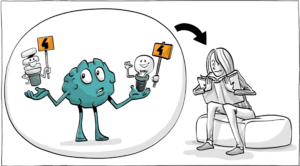Cognitive dissonance theory: Difference between revisions
Alice zhang (talk | contribs) |
Alice zhang (talk | contribs) |
||
| Line 9: | Line 9: | ||
==Design Implications== | ==Design Implications== | ||
[http:/www.simplypsychology.org/cognitive-dissonance-example.jpg?ezimgfmt=rs:553x526/rscb36/ng:webp/ngcb36.for/some/Example of smoke.png] | [http://www.simplypsychology.org/cognitive-dissonance-example.jpg?ezimgfmt=rs:553x526/rscb36/ng:webp/ngcb36.for/some/Example of smoke.png] | ||
==Challenges and/or Alternative theories== | ==Challenges and/or Alternative theories== | ||
Revision as of 23:58, 13 December 2022
Overview
In cognitive dissonance theory, people seek consistency between what they believe and what they do. According to the theory, people strive for consistency between what they believe and what they do [1]. When there is an imbalance between the two, tension is created. Cognitive dissonance can be reduced by changing either beliefs or behaviors so that they become mutually consistent and harmonious. There are times when people change their behavior to match their beliefs; this is often seen as an ethical imperative since we should practice what we preach [1]
.
Evidence
Design Implications
Challenges and/or Alternative theories
References
- ↑ 1.0 1.1 Martinez, M. E. (2010). Learning and cognition: The design of the mind. Perusalk (Vol. 6). Merrill. Retrieved December 13, 2022, from https://app.perusall.com/courses/foundations-of-cognitive-science-for-learning-f22/learning-and-cognition-the-design-of-the-mind?assignmentId=ZKHADfR8srroXsmKM&part=1.

